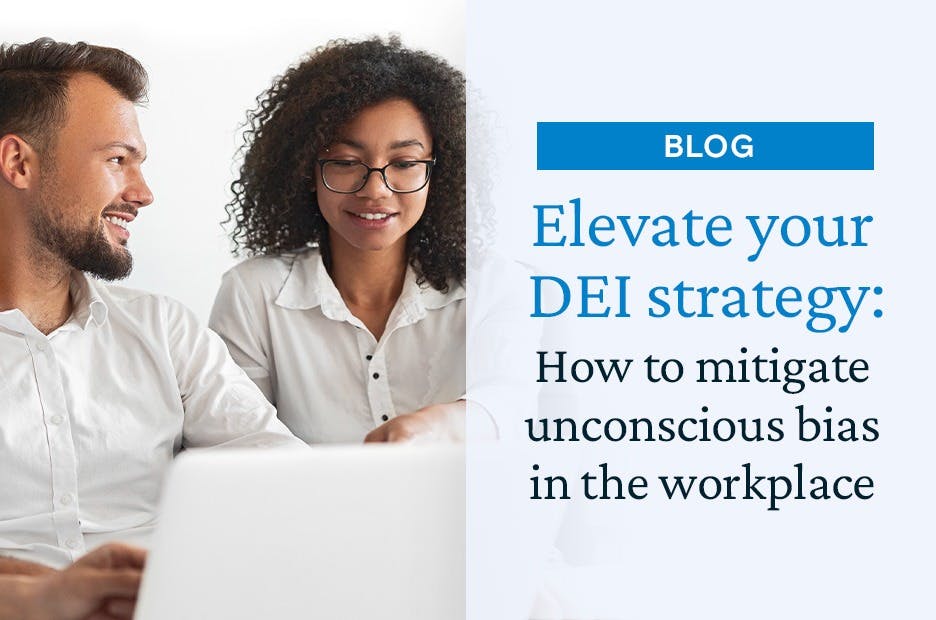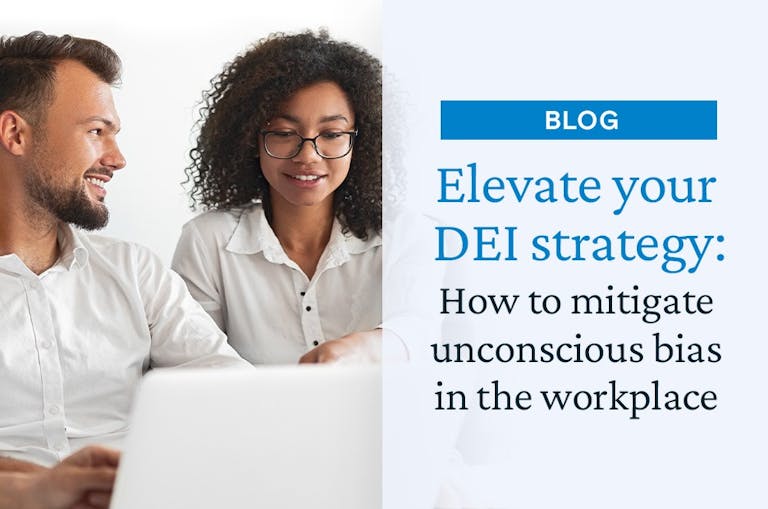Modern organizations are making diversity, equity and inclusion (DEI) a priority in their business practices. But despite implementing robust DEI initiatives, it can still be a struggle to make meaningful progress on these issues — especially when it comes to unconscious bias.
Even with the best intentions, people can still be complicit in modes of biased thinking at an unconscious level. This is especially harmful in the workplace, where biases can directly affect employee performance and contribute to a toxic work environment. One study shows that 34 percent of employees who reported experiencing bias at work revealed that they withhold ideas and 80 percent would not refer their employers to others.
Let’s take a closer look at what unconscious bias means in the workplace and discuss how leading companies are eliminating bias as part of their greater diversity, equity and inclusion strategy.
What is unconscious bias in the workplace?
Unconscious bias, also referred to as implicit bias, is a set of underlying beliefs or attitudes about other individuals or groups of people. This typically includes stereotypes, and can dramatically alter the way an individual interacts or views others around them.
What makes unconscious bias particularly difficult to address is that people aren’t always fully aware of these beliefs. It’s possible for a person who understands harmful stereotypes or prejudices to still perpetuate oppressive ideas related to sex, race, age, etc. without knowing it.
Implicit vs. explicit bias
When bias is implicit, the individual is not consciously aware of it. On the other hand, explicit biases are prejudices people have that they are fully aware of. These are conscious beliefs about other people that perpetuate stereotypes and generalizing attributes.
Examples of unconscious bias in the workplace
To effectively address unconscious bias at work, it’s important to remain aware and honest about how it manifests in a working environment. Here are a few unconscious biases example and how they can take shape at work:
- Gender bias is the preferential treatment of men over women. Although this type of bias is at the forefront of discussions around DEI, it’s still prevalent among today’s workforce — especially when looking at the lack of gender diversity in leadership positions.
- Racial bias is the preferential treatment of one race over another; overwhelmingly white individuals over Black, Indigenous, and other people over color (BIPOC). Resumes with African, Asian or Latinx names are less likely to receive callbacks for job interviews.
- Age bias is the specific negative treatment or ideation of people based on their age. This is usually experienced by older individuals: 58 percent of workers report experiencing incidents of ageism after they turn 50.
- The halo effect is the preferential treatment of another individual formed from a single impression based on a characteristic. People tend to put a “halo” on others that they deem to be impressive. This could result from learning that someone attended a prestigious university or simply be based on the way they’re dressed.
How unconscious bias affects the workplace
Unconscious biases can take a massive toll on the well-being of your employees and may cost an organization money, time and employer reputation if not addressed properly.
- Bias in hiring significantly limits access to top talent. And although you’ve likely already carefully vetted your recruitment and hiring processes for bias, it’s important to revisit them periodically. This ensures that your diversity recruitment strategy evolves and your hiring staff is up-to-speed on best practices.
- A homogenous culture within an organization can be a major detriment to innovative thinking and ideation.
- If not addressed, unconscious biases may become explicit in homogenous work cultures. Mistreatment of marginalized employees may escalate to bullying or other forms of workplace harassment.
- Workers who feel alienated or unsafe due to unconscious bias in the workplace are less likely to want to stay with your company. This can lead to high levels of turnover and a negative employer brand reputation.
- Employees who feel alienated or unsafe at work are significantly less engaged at work. This affects both productivity and the quality of the overall company culture and morale.
How to reduce and prevent unconscious bias at work
In recent years, companies have come a long way when it comes to elevating DEI initiatives in the workplace. From pioneering for more diverse recruitment practices to advocating for employee education, corporate culture as a whole is making progress toward a more just and equitable future.
With that in mind, it’s important to revisit your existing DEI strategy and look for ways to mitigate bias throughout every process — from hiring to promotions and everything in between. Here are a few key areas to consider:
- Revise the language in your job descriptions to ensure that they’re inclusive.
The language used in your job descriptions might unintentionally discourage diverse candidates from applying for positions. For example, terms such as “champion” can be seen as having masculine qualities and may make women think that this job isn’t for them. You can attract a wider pool of talent by eliminating gendered language from your job listings. - Prioritize employee education.
During the hiring process, consider candidates who may not have had access to quality education but possess the right skills, aptitude or potential for the job. You can then invest in their ongoing growth and provide them with the educational opportunities to maximize their relevant skills. - Form inclusive hiring teams.
Homogenous hiring teams are more likely to hire new employees who look, act and think like them. However, a diverse hiring team will be more likely to hire diverse employees and can be trained to form decisions based on skill rather than background, gender or social standing. - Hold team members accountable.
When there are instances of unconscious bias among employees, it’s critical to have processes built in place to intervene. Most commonly, organizations leverage training programs that are specifically designed to address unconscious bias as a way to raise awareness. Although this solution can be effective at educating staff, it should be just one part of a greater strategy to mitigate bias.
Take your DEI initiatives further by addressing unconscious bias
As business leaders continue to uplift DEI, recognizing and addressing bias becomes paramount. In doing so, you’re able to accelerate your business, cultivate a more inclusive company culture and make a meaningful positive impact on the lives of your employees.
Moving the needle on workplace diversity, equity and inclusion starts from the top down. Download this free DEI strategy and measurement template to arm your executive team with everything necessary to help move your efforts forward.

